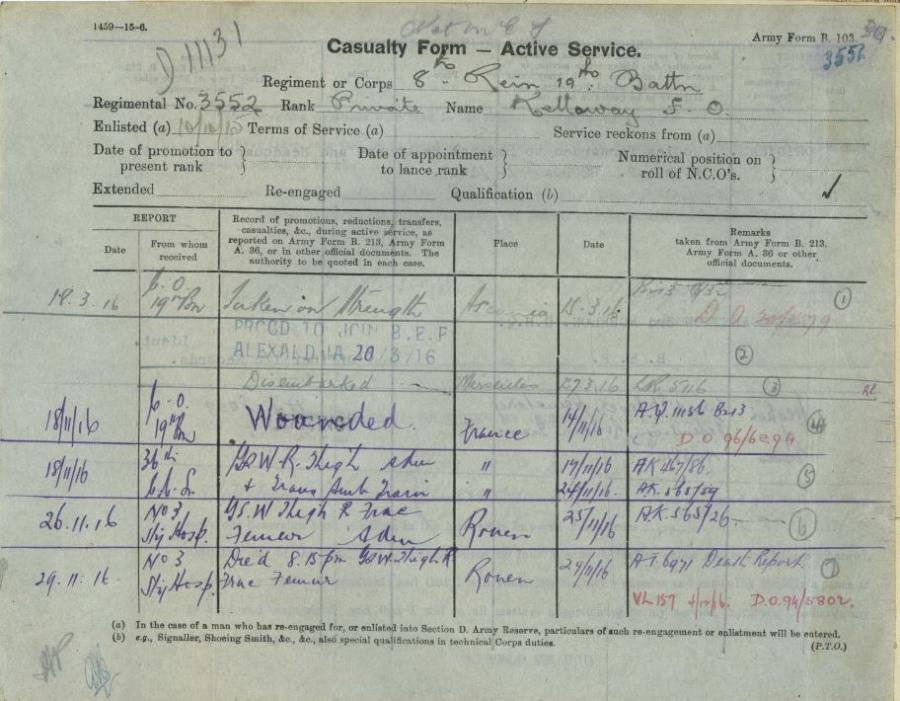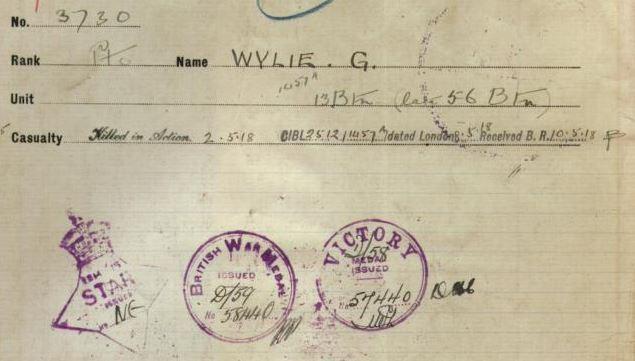Step by step guide
A step by step guide
Researching a First World War soldier
Getting started
The Australian War Memorial website is a good place to start researching someone who served in the military during a war. Several sources on the Memorial’s website give basic information about a soldier such as service number, rank, date of joining and other details. These can be found on the People search page and include:
- First World War Embarkation Roll
- First World War Nominal Roll
- Roll of Honour (for those who died)
- Honours and Awards database (for those who were awarded medals other than general campaign medals)
- Red Cross Wounded and Missing files (information about some Australian soldiers who were reported wounded or missing)
First World War Embarkation Roll
The Embarkation Roll lists most of the members of the Australian Imperial Force (AIF) as they left Australia for service overseas in the First World War. Embarkation means to board a ship for travel. The Embarkation Roll entry shows the date the soldier embarked, the name of the troopship on which they travelled and the date they boarded the ship. You can click on the link to view the digitised record to get more information including their age, occupation, where they lived, and who they named as their next of kin when they enlisted.
An Embarkation Roll search for Albert Thomas Abrey shows that he was a 23-year-old gardener from North Sydney. He embarked with the 1st Reinforcements, 1st Infantry Battalion on HMAT Themistocles on 22 December 1914. His service number was 1101. The roll also shows that Albert’s father lived in Sussex, England, and was named as his next of kin.

First World War Nominal Roll
The First World War Nominal Roll is an alphabetic list of about 324,000 members of the AIF who served overseas during the First World War. The Nominal Roll will tell you whether an individual returned to Australia (RTA), was killed in action (KIA), died of wounds (DOW) or was discharged. It will also give you the date when this occurred and the unit the person was attached to at the time.
A Nominal Roll search for Thomas Charles Milward shows that he returned to Australia on 18 July 1919. This tells us that Thomas survived the war.

Roll of Honour
The Roll of Honour records the names of those who died while serving with Australian forces during wartime. Roll of Honour entries list the person’s date of death and the unit they were serving with at the time. In most cases the entries also include the place of death, cause of death, and the cemetery or memorial where they are buried or commemorated. If someone is listed on a memorial it generally means their body was never recovered and there is no known grave for that person.
Many entries for those who died in the First World War have a copy of a completed Roll of Honour Circular attached to them. After the First World War, these forms were sent to the deceased's next of kin, asking for information about them.
Leslie Thomas Prior is on the Roll of Honour. He died at Bullecourt, France, while serving with the 23rd Battalion. His circular says that he had been a labourer before enlisting, and that he was only 15 years and three months of age at the time of his death.

Finding more information
To find out more about a person’s military service, such as where they went and what they did, you need to look at both their service record and records about their unit.
Service records
The service record is a file kept by the military about a person during their military service. These records contain enlistment forms, a service and casualty form recording their movements between units, discharge documents, and sometimes letters and other correspondence.
Service records are held by the National Archives of Australia. First World War service records have been digitised and are available to read online. You can search these using the NameSearch function in RecordSearch. Search using your person’s surname and select the type of records you need (e.g. army personnel records). At the next screen you can narrow down your search using your person’s first names or service number.
Some examples of the papers you may find in service records.
The attestation paper includes a person’s age, address, occupation, next of kin, date of enlistment, and some other details.
The casualty and service form has a number of columns for different information. In the “date” column on the left you can see the date an entry was made. “From whom received” usually refers to the commanding officer (CO) of the unit. The next column shows each event. Here you will see things like embarkations, arrivals, “m/i” or “tos” (marched in or taken on strength, which means being added to a new unit), promotions, admissions to hospital, and other events. The second date column shows the date the event took place.
Frederick Oscar Kelloway was taken on strength in the 19th Battalion on 18 March 1916. His casualty and service form shows he was wounded on 14 November 1916, admitted to the 36th Casualty Clearing Station on 17 November 1916, and died at No. 3 Stationary Hospital, Rouen, on 29 November 1916.

There is usually a page towards the back of a First World War service record with three purple stamps. Each of these represents a service medal. You can use the stamps to work out which medal(s) your person received. If the stamp is marked “NE”, this means they were not eligible for that medal. If the stamp is marked with a serial number then the person was issued with that medal.
George Wylie was awarded the British War Medal and the Victory Medal, but was not eligible to receive the 1914/15 Star.

Service records often use abbreviations and jargon that can be difficult to understand. The Memorial’s Glossary explains abbreviations that are common in service records. If you cannot find what you are looking for in the glossary please contact the Research Centre for assistance.
The service record does not show exactly where the person served. However, the service and casualty forms will list which unit the person served with and when. You can use these to trace where the unit served during the time the person was attached to it.
Information about units
Unit profiles
The Memorial has published a series of profiles for a selection of Australian units. These may include:
- short history of the unit
- details of its casualties
- decorations
- details of battles in which it participated
- commanding officers
- for technical units, the equipment it used.
War diaries
For detailed information about what a unit was doing you can look at their war diaries. These records were kept by the commanding officer of a unit to record daily activities and locations. The Memorial has digitised the First World War unit diaries. Because these are original records from the time, they can be difficult to read and may contain gaps.
The unit diary for the 60th Battalion shows that on 19 July 1916 the unit was located in the trenches and took part in the Battle of Fromelles. The entry records that the battalion “advanced under very heavy artillery, machine gun and rifle fire, suffering very heavy casualties”. Over 350 members of the 60th Battalion were killed in action on that day, including 16-year-old Clarence George Mathieson from Richmond, Victoria. The diary records that at roll call the following morning there were four officers and 61 other ranks present.

Other sources of information
Official histories
Official histories tell the story of what Australian serving men and women did during the war. You can use the official histories to find out more about a particular battle. Often they will include a map or sketch of the area where the battle took place.
The Official History of Australia in the War of 1914-1918 is available online.
Newspapers
Newspapers can be great sources of information. Some Australian newspapers published during the war years have been digitised and can be viewed on the National Library of Australia’s Trove service.